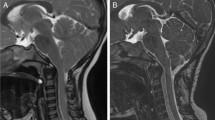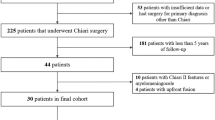Summary.
Background: Posterior cranio-cervical decompression by opening at least foramen magnum and C1-lamina usually with corresponding dural and arachnoid opening, is the procedure most currently used for treating Chiari I malformation (alone or in association with syringomyelia). To optimize decompressive effects together with reducing risks, a procedure was developed which consists of a sub-occipital craniectomy and a C1 (or C1/C2) laminectomy, plus an extreme lateral Foramen Magnum opening, a “Y” shaped dural incision with preservation of the arachnoid membrane, and an expansile duroplasty employing autogenous periosteum.
The purpose of the article is:
1. to report the long-term functional results in a consecutive series of 44 adult patients affected by symptomatic Chiari Malformation type I (CM) using the procedure described.
2. and to compare this technical modality with the other modalities reported in the literature.
Method: This series includes 44 patients harboring CM type I and operated on between 1990 and 2000. 15 patients had CM with syringomyelia (34%) and 29 CM alone (66%). Functional status was evaluated by using the Karnofsky disability scale. Before surgery 37 patients (84.1%) were independent (of whom 13 had syringomyelia) and 7 patients (15.9%) were dependent – i.e., they required assistance – (of whom 2 had syringomyelia). Outcomes were analized with follow-up ranging from 1 to 10 years (4 years on average).
Findings: There was no operative mortality, and surgery did not provoke any neurological aggravation. After surgery all the patients were independent. For the patients with CM only, the averaged Karnofsky score was 90 at latest follow up, versus 76 before surgery. For the patients with syringomyelia, the averaged latest Karnofsky score was 89 after surgery, versus 74 before.
Interpretation: The presented technique was compared with the other surgical modalities reported in the literature. This comparative study shows that cranio-cervical decompression with extreme lateral resection of the posterior rim of Foramen Magnum out to the level of the occipital condyles on either side, associated with an enlargement duroplasty with preservation of the arachnoid membrane, achieved the best results with minimal complications and side-effects.
Similar content being viewed by others
Author information
Authors and Affiliations
Additional information
Published online October 10, 2002
Acknowledgments We thank Mrs Brigitte BAUER for her secretariat assistance.
Correspondence: Professor Marc Sindou, M.D., D. Sc., Department of Neurosurgery, Hôpital Neurologique Pierre Wertheimer, University of Lyon, 59 Bd Pinel, 69003 Lyon, France.
Rights and permissions
About this article
Cite this article
Sindou, M., Chávez-Machuca, J. & Hashish, H. Cranio-Cervical Decompression for Chiari Type I-Malformation, Adding Extreme Lateral Foramen Magnum Opening and Expansile Duroplasty with Arachnoid Preservation. Technique and Long-Term Functional Results in 44 Consecutive Adult Cases – Comparison with Literature Data. Acta Neurochir (Wien) 144, 1005–1019 (2002). https://doi.org/10.1007/s00701-002-1004-8
Issue Date:
DOI: https://doi.org/10.1007/s00701-002-1004-8




